Northern rivals of Columbus
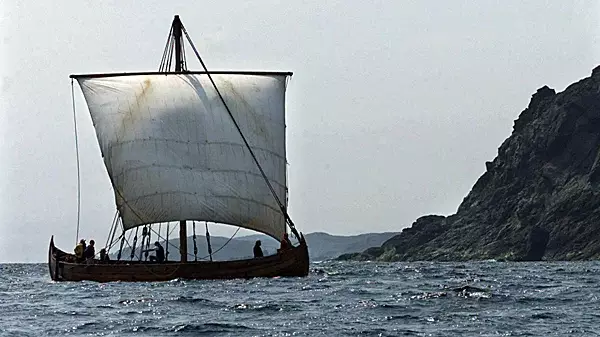
A replica of the Maine-built Viking ship Snorri passes by an island near L'Anse aux Meadows, North Carolina, in July 2000. The ship was named Snorr after the name the Vikings gave to the first child born in the New World. It is equipped with only a square sail and oars
Some lyrics
For anyone on the northern tip of Newfoundland, on the windswept coast of L'Anse aux Meadows Bay, it's hard to grasp the magnitude of the archaeological site that stretches around it. Here in L'Anse aux Meadows lies what is still the only known Scandinavian settlement in North America.
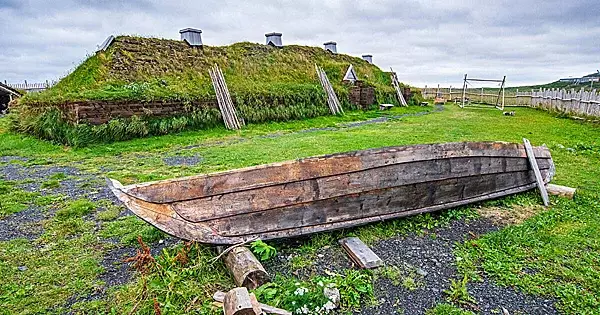
L'Anse aux Meadows is a UNESCO World Heritage Site that houses amazing archaeological finds from the Viking Age in North America
Just a few small mounds and bumps in the grass, an exact copy of the dwelling and a recently erected museum, fix the point of first contact between people living on opposite sides of the Atlantic. It is quite obvious to all those who are interested in the northern campaigns of the Vikings that this place is amazing, but its significance has been recognized by scientists only in relatively recent decades.
A bit about the Viking Age
The campaigns of the Scandinavian Vikings have been exciting for several generations of people who are not indifferent to history, not only because they left behind a literary heritage in the form of a large number of sagas in the Old Norse language with many vivid and exciting adventure stories, but primarily because they played a significant role in history of Europe, founding new cities, monarchical dynasties and even entire countries ...
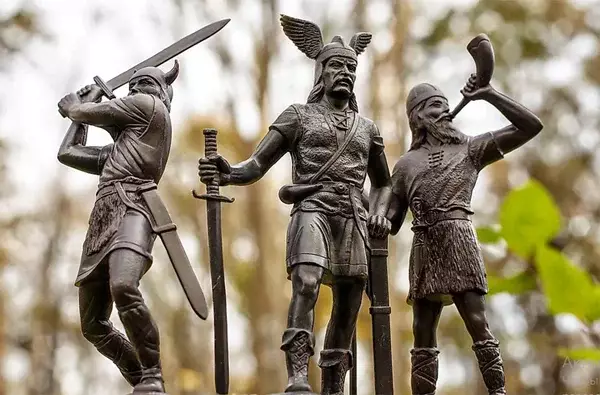
Sculptural composition of the Scandinavian god Odin with two Vikings. Digital work by Alexander Shagivaleev
The first years of the so-called. the Viking Age (VIII-XI centuries) - these are just the robber raids of the kings with their desperate squads on the coastal cities of Northern Europe. And one of the first signs of the expansion of the Vikings, which marked the beginning of the Viking Age, was the attack on Lindisfarne Monastery in 793, located in northern Northumbria (England) on the island of the same name.
Having landed on the island, a detachment of Scandinavians attacks the unguarded Lindisfarne Monastery. The Vikings kill its abbot and most of the monks involved in the census of books, and then rob and burn the monastery itself. It should be noted here that the famous Lindisfarne Gospel, containing the texts of the gospels of Matthew, Mark, Luke and John and provided with rich illustrations, was created by the monks of this particular monastery.
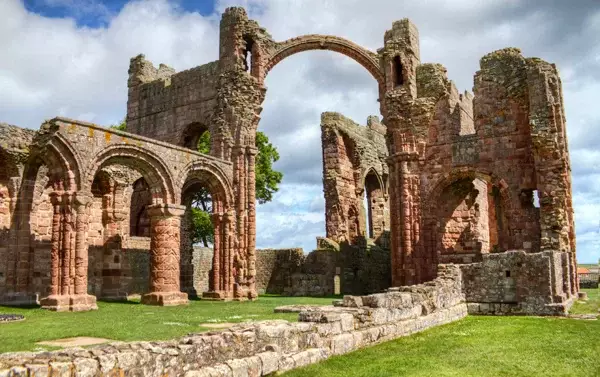
Ruins of Lindisfarne Monastery. In 1537, during the Church Reformation, Henry VIII ordered it closed.
To quote from the Anglo-Saxon Chronicle for 793:
Every year the Scandinavian sea robbers are gaining more and more strength, and their new military expeditions amaze with their wide scope and audacity. And if at the very beginning of the Viking Age in European countries they were looked upon simply as robbers who quickly plunder and just as quickly swim away with the loot they looted, then starting from the XNUMXth century, just one prey is already not enough for them, and they begin to establish their own permanent presence in various territories and create a semblance of states.
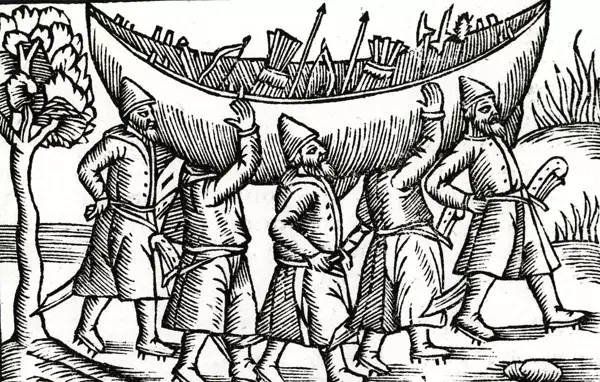
Illustration from a XNUMXth-century chronicle titled Historia de Gentibus Septentrionalibus ("History of the Northern Peoples") by Olaus Magnus depicting a group of Scandinavians carrying their longship overland
This is how the French historian and specialist in the history of the countries of Northern Europe Regis Boyer* describes the end of the Viking Age in his book: “The Vikings. History and Civilization":
* This article describes attempts to settle and explore the newly discovered territories of Iceland, Greenland and the northeast coast of the American continent. It tells about the voyages of ancient Scandinavian sailors in the northern part of the Atlantic in search of new and suitable lands for further life ...
First European
The story goes that about a little over 1000 years ago, a Norwegian navigator and merchant, someone named Gunnbjorn Ulfson, heading from Norway to Iceland, lost his way due to a strong storm and saw a small group of islands beyond Iceland, which he modestly named after himself. - "Skerries of Gunnbjorn". It is still not known exactly what kind of islands they were, but they can definitely be attributed to a number of archipelagos located northeast of Greenland. He did not land on these islets, but he told others about them when he arrived in Iceland. And if the approximate localization of these seen archipelagos is correct, then Gunnbjorn Ulfson can be safely attributed to the first Europeans who saw the shores of the New World.
Note. Looking ahead, we can say about the first European born on the American continent - this is one Snorri, the son of the Icelandic navigator and adventurer Thorfinn Karlsefni and his wife Gudrid Thorbjarnardottir, who sailed from the western coast of Greenland on three ships with a squad of dashing Vikings to explore quite recently an open new land that promised them unheard-of riches.
Second European
Having heard the stories of Gunnbjorn Ulfson about the unknown land he saw in the west, in 978 an expedition to the west of the Icelandic coast was set up by a certain Snabjorn, nicknamed Borov, who was hiding from blood feud for a murder in Iceland. This desperate Icelander already had a rough idea of where exactly the Gunnbjorn skerries were located.
Equipping a ship with the same desperate seeker of profit and adventure, a certain Hrolf, and recruiting a team, they set off on a journey and reached small islands, seen from afar by Gunnbjorn Ulfson. On one of these small islands they decided to spend the winter, but there was a quarrel between the participants of this trip over money, and Snaebjorn was killed by Hrolf, his companion.
The team that returned back to Iceland told everything to the hövding (tribal leader among the ancient Scandinavians) Thorkel, nicknamed Fringe, and he dealt with Hrolf and the second accomplice in the murder of Snabjorn with the help of a hired killer. A saga was even composed about this journey to the western lands, but, unfortunately, its text has not been preserved to this day.
It is worth paying attention to the fact that Snaebjorn and Gunnbjorn saw the islands belonging to North America, but not the mainland itself. The mainland itself was still discovered somewhat later.
Third European
Much of what we know about Eric Thorvaldson, aka Eric the Red, is taken from the Scandinavian sagas. He made such a name for himself thanks to his quick temper, propensity to explore the world and fiery red hair.
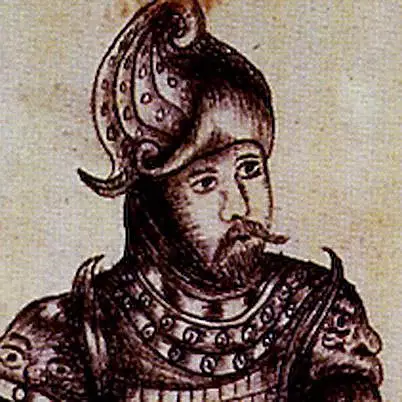
Eric the Red
Eric the Red may have entered the history of sea voyages as the father of another Viking explorer, Leif Erickson, who reached the very North American Newfoundland, but he is also remembered as the founder of the first known European settlement in North America - and all thanks to his violent temper. And perhaps he would never have discovered Greenland and founded settlements there if he had not been expelled from Iceland for two murders. According to the sagas describing his life, he was born in 950 in Norway, but his father Thorvald Asvaldsson was also accused of murder and was also expelled, only from Norway, from where he moved his family to western Iceland in the Hornstrandir region.
The earliest Scandinavian settlers settled in Iceland around 860, and by the time Eric and his father arrived from Norway almost a hundred years later, most of the land was already occupied.
Note. Before the arrival of the Norwegians on the island, Iceland (the country of Thule*) were inhabited by Irish monks, known as "Paparas", but they soon abandoned this infertile land and not very comfortable climate, and the pagan Norwegians arriving on the island did not make their stay there pleasant. And the settlement of Iceland by the Scandinavians began to occur in the XNUMXth century, when some families, after the unification of Norway, did not recognize Harald I as their king and came into conflict with him, were forced to leave Norway in search of a new place to live. A little later, immigrants from Iceland began to settle in Greenland, and these people were the first Europeans to see the North American continent. The emigration of disaffected people from Norway was so great that King Harald I the Fair-Haired* for fear of weakening the country, he tried to prevent the departure of his subjects by imposing a special exit tax on them.
And it was on this harsh and wild land that Eric the Red forged and, in the temper of his character, began to look more and more like his father.
After his father's death, Eric the Red marries a wealthy woman named Thjodhild Jorundsdottir, inherits her family's wealth, and becomes a wealthy and respected bondman in this small northern community. That was until his quick-tempered and belligerent temper got the best of him - he followed in the footsteps of his violent father, was outlawed and sentenced to exile for three years for several murders.
Note. According to Icelandic law, a person sentenced to exile was outlawed, he himself had to leave the island, and all his property was confiscated. If for some reason the person sentenced to exile did not manage to leave the island for three years, then his exile became already complete, and other residents were forbidden to help him with shelter, food or help in sailing from the island. Some researchers believe that the reason for Eric's departure from Iceland to the west was the unwillingness to become an outcast in Iceland.
Having gone into exile with his family from the Icelandic Breidfjord, on the shore of which he lived, Eric reached that mysterious land that the “first European” Gunnbjorn Ulfson saw to the west of Iceland and which he wanted to settle four years before, but without success, “ second European" - Snebjorn Borov, and Eric was also determined to populate this land.
In 983, rounding the southern tip of the island, later known as Cape Farewell (Grenl. Nunap Isua), Eric reached his goal at the southernmost tip of the fjord, now known as Tunulliarfik (or otherwise Eiriksfjord), and reached that part of the coast, which for the most part it seemed to him free of ice and, in his opinion, had climatic conditions similar to those of Iceland, promising wealth and prosperity in the future.
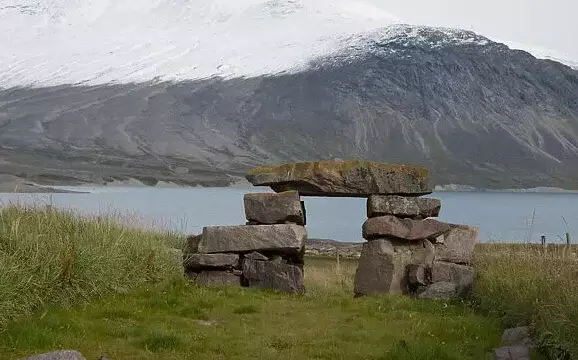
Eiriksfjord (Tunulliarfik)
Even while in exile, this fearless explorer drew a map of Greenland for three years and found areas most suitable for raising livestock, and in order to attract as many settlers as possible to the island, despite the cold climate, he named this place Greenland, which means "Green Land". I must say that in the summer on this coast you can actually see glades with flowering green grass. Here is how the "Saga of Eric the Red" tells about this event:
In 985 (according to other sources - in 986), the term of his exile ended, and Eric returned back to Iceland. His descriptions of the new land in the west were obviously so tempting that, after spending the winter in Iceland, he set off with a large number of colonists on 25 ships, of which only 14 reached Greenland safely, and founded two colonies there on its coast. These were the Eastern settlement (Eistribigd, modern Kakortok) and the Western (Vestribigd, modern Nuuk).
And although, according to the sagas, it is generally accepted that only 14 of these ships with 350 colonists on board got there safely, the settlement eventually grew to about 3 inhabitants in a short time and consisted of 000 farms, 190 churches, a male and female monastery. The Greenlandic settlers created their own free state with their own laws and courts, in no way dependent on their former mother countries - Iceland and Norway. But in 12 they had to submit to the Norwegian king
Hakon IV Hakonsson, and Greenland became part of the Norwegian kingdom.
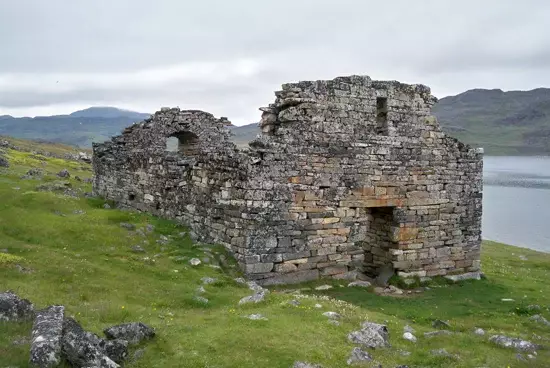
Ruins of the Scandinavian stone church from Hvalsey, the best preserved in Greenland
Using the right of the discoverer of these lands, Eric declared himself the supreme leader of these settlements, allocated the most fertile plots of land for himself, and soon became the richest man on the island.
After settling in Vestribyggd, Eric sailed north along the western coast of Greenland, with the rest of the island being almost uninhabited land inhabited only by the Inuit (Eskimos). The fact that the Icelanders, who settled in Greenland, went far to the north, is evidenced by a rune stone found in the north-west of Greenland - the island of Kingigtorssuak.
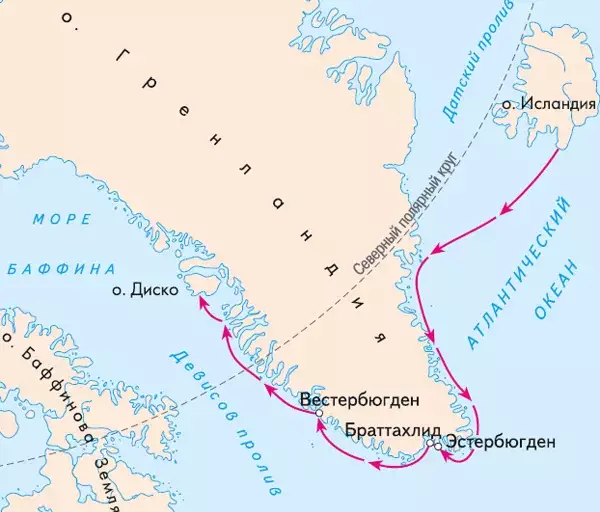
Swimming of Eric the Red along the coast of Greenland
On this sparsely populated and harsh land, the new settlers mastered a small strip along the coast, mainly engaged in fishing and hunting. But after some time, unusually cold weather conditions set in in the new settlements, and some of the settlers returned back to Iceland (the last recorded trip between Iceland and Greenland was in 1410), and the rest of the settlers disappeared.
Regarding the disappearance of the first colonists, there are two versions - either the Inuit (Greenland Eskimos) attacked and exterminated all the settlers, which is not very reliable - the Inuit were and remain deeply peaceful people, or they died from epidemics and hunger.
Note. The re-colonization of Greenland began in the first half of the XNUMXth century after the creation of a union of two states - Denmark and Norway, which belonged to Greenland. Curiously, in these two countries bound by the union, it was still believed that the Norse settlements in Greenland survived, and they continued to claim sovereignty over the island, even despite the absence of any contacts between Greenland and the mainland ...
Eric the Red died in 1003 at the age of 53 on the land that became his second home and, according to legends that have come down to us, he was buried according to the pagan custom of the Vikings. Eric, although he did not reach the American continent, nevertheless he remains the first permanent European settler ...
Fourth European
In the Greenlandic village of Brattalid, with a population of just over fifty people, which today is known by the Greenlandic name of Kassiarsuk, a bronze statue of Leif Erickson was erected in memory of his amazing discoveries at the beginning of the second millennium. The commemorative statue is installed in the south of Greenland in the place where the legendary son of Eric the Red, who discovered and then settled Greenland, headed for the still unexplored lands of the West from his childhood home.
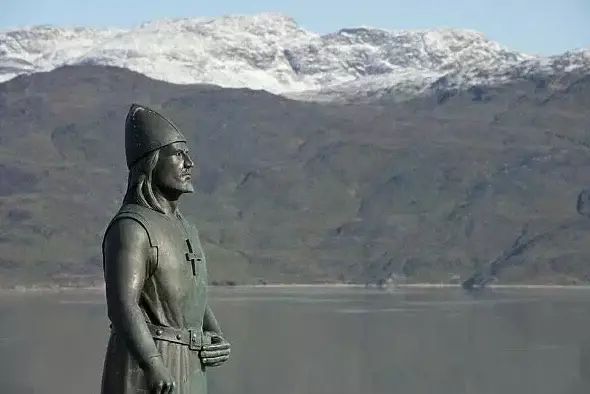
Monument to Leif Erickson, erected in the Greenlandic village of Brattalid
Traveling to these uncharted lands, called America five centuries later, made Leif Erickson, later nicknamed "Lucky", the first European to set foot and explore the east coast of the North American continent, in particular, those areas that are now part of the Arctic and Atlantic territory of Canada.
Note. A more detailed description of the campaigns of Leif Erickson is contained in two main sources - the Greenlanders Saga and the Eric the Red Saga, which are the main sources of information about the discovery of America. There are also small references to these events in Olaf Tryggvason's Saga and St. Olaf's Saga. But here we must not forget that the sagas are just generalizing oral narrative works about significant events, passed down from generation to generation until they were recorded in Iceland only in the XIII-XIV centuries, which means that they have only visible authenticity. . And this means that all the details of sea voyages in the process of oral transmission must be subject to some changes, so one should not rely on the description of the details in these narratives.
So who was this Leif Erickson? And he was the son of Eric the Red, the same "third European" and the founder of the first European settlement in the territory that is now called Greenland.
From the Saga of Erik the Red, we know that Leif, who was born in Iceland around 970, sailed to Greenland with his father, who was expelled from Iceland into exile for murder, and lived there in his father's estate (Eastern Settlement) until about 1000, after which he arrived in Norway on business, where he spent the winter at the court of King Olaf I Trygvason (a former pupil of the Kiev prince Vladimir) and there, at the insistence of the king, he adopted the Christian faith.
And when Leif announced his intention to return back to Greenland, Olaf I provided him with a priest and ordered him to convert all the inhabitants to Christianity, and in the spring of 1000, before Leif sailed, the Norwegian king Olaf I sent through him in a message to the Vikings living in Greenland, his call to accept Christianity.
Following the orders of the Norwegian king Olaf I, Leif brought a Christian bishop to Greenland, who converted his mother to the Christian faith, which was followed by many other Greenlanders, but his father, Eric the Red, dissatisfied with the actions of his son, said that he "brought a rogue”, so he called the priest and remained a pagan until his death.
Note. Many researchers doubt that Christianity arrived in Greenland so early, believing that it must have arrived at least a decade or more after Leif's visit to Norway, but archaeological evidence from a Greenlandic settler colony clearly points to the existence of a Christian church and a nearby cemeteries that people were buried according to the Christian rite since the end of the tenth century. In addition, it can be assumed that, apart from Leif Erickson's own religious beliefs, the friendship between him and King Olaf and the position that Leif received with the support of the Norwegian king are sufficient to explain why he could take on this religious mission.
After returning from Norway to Greenland, Leif heard the story of an Icelander named Bjarni Herjulfson, who said that he saw, far to the west, the outlines of some land covered with forests, which from afar looked habitable. Leif was interested in this story of Herjulfson, and he decided to go on a journey himself and explore unknown lands.
Leif buys a ship from Bjarni Herjulfson, recruits a crew of 35 and asks his father Eric the Red to lead the expedition, but his horse stumbles under Eric and he falls to the ground. After that, deciding that this is a bad omen, Eric passes the command of the expedition to his son Leif:
The first land that the travelers reached had a flat and rocky mountainous landscape, all covered with a glacier. Leif called this land Helluland (Flat earth). Modern researchers believe that the largest island of modern Canada, Baffin Island, is most suitable for such a definition.
Leif named the second land they encountered on their way Markland (Borderland). This land was low-lying and wooded and is described as similar to the Labrador Peninsula.
Continuing on their way, they sailed to the next island lying to the south, where they disembarked, deciding to stay here for the winter and build houses.
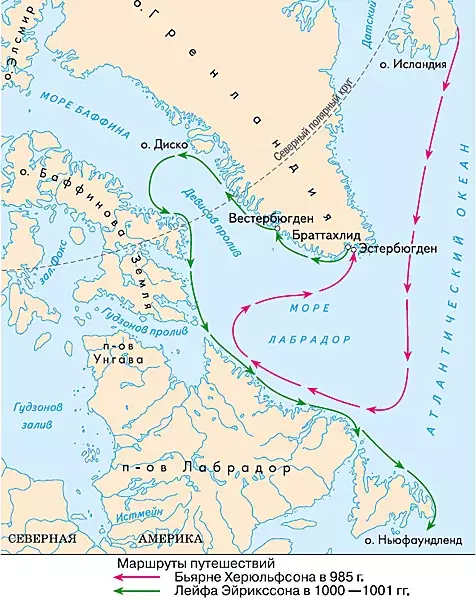
The places turned out to be rich in fish, and livestock did not even require fodder for the winter, because local frosts did not destroy the grass. In addition, after a closer examination of the island, it was discovered that vines grow here, so Leif called this land Vinland ("Country of Grapes"). Apparently, this was the coast of the island of Newfoundland, not far from the modern town of L'Anse-aux-Meadows, where the first settlement was founded and where the Vikings stayed for the winter.
Note. A curious observation about the name "Vinland" is made by Regis Boyer* in his book Vikings. History and Civilization":
Leif and his companions spent the whole winter on the territory of Vinland discovered by him, where the sailors built a small settlement of wooden huts and modestly named after Leif - Leifsbudir, after wintering there, they returned to Greenland.
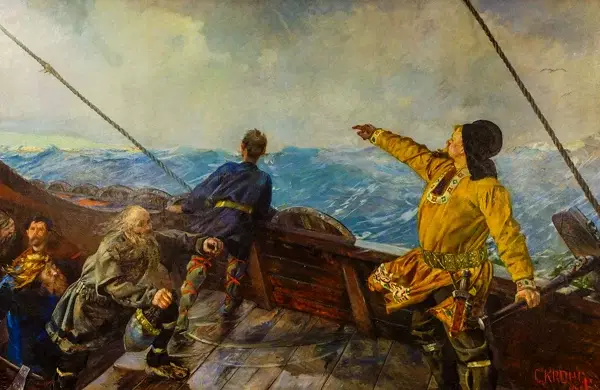
Painting "Leif Eirikson Discovers America". Author: Christian Krogh, 1893
In winter, after Leif returns from a distant expedition, his father, Eric the Red, dies, and Leif becomes the hövding (supreme leader) of Greenland. Leif Erikson was last mentioned alive in 1018 in the Saga of St. Olaf, according to the Saga of the Named Brothers, by 1025 the rule of Eiriksfjord passed to his son Thorkel ...
* The "Greenlanders Saga" tells that already next year, following in the footsteps of Leif, having recruited a team of 30 people and on his own ship, his younger brother, Torvald, set off on his way to the West. Starting to explore the land discovered by Leif, they found that this area was rich in forest, and on one small island they even noticed wild wheat. But Torvald's expedition was unsuccessful. Having reached Vinland, he found the village of Leifsbudir and spent the whole winter and summer there, after which he moved north and, rounding the cape, which he called Kjalarnes (modern Labrador), met with the Screlings*, in a skirmish with which he was killed by an arrow fired at him.
The Icelandic sagas describe the appearance of the Skrelings:
In addition to the above, it must be added that another expedition was sent to the country of Vinland by the third and youngest son of Eric the Red, Thorstein, who wanted to take the body of his brother and take him home. He managed to recruit a team of twenty-five people and go with them to Vinland, but in the winter an epidemic of some kind of disease spread among the crew, from which many sailors from the team died, including Thorstein himself.
What does archeology say?
Until the second half of the 60s of the last century, Viking voyages to North America were known only thanks to the Icelandic sagas, which are the pride of Scandinavian medieval literature. But that was before Norwegian explorer Helge Markus Ingstad and his wife, archaeologist Ann Stein Ingstad, discovered the first Viking settlement on the island of Newfoundland at L'Anse aux Meadows. This site, which later became a UNESCO World Heritage Site, has been the site of extensive archaeological work that has yielded much information about the first Viking settlement, and wood analysis of half-timbered buildings in Newfoundland shows that the settlement was built by Scandinavians 471 years before Columbus's voyage.
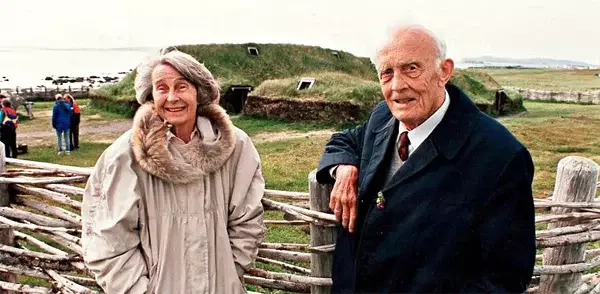
Helge Markus Ingstad with his wife, archaeologist Ann Stein Ingstad
Based on the analysis carried out by scientists, it can be assumed that the Newfoundland settlement of L'Anse aux Meadows existed approximately between the end of the 90s and 1050. Such an assumption was based on a careful analysis of the architectural remains and several artifacts found, in particular a bronze cloak pin and iron nails, explored after the Viking settlement was discovered. And this all coincides with the narrations of the Icelandic sagas, which were written down only in the XNUMXth century.
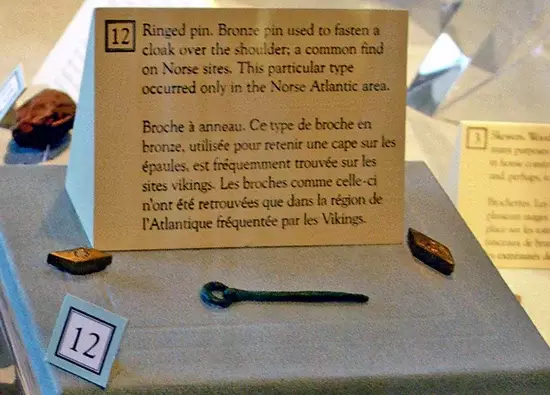
This cloak pin is one of the testimonies of Scandinavian presence in the North Atlantic over 1000 years ago. L'Anse aux Meadows Museum, Newfoundland
And here is what the British The Guardian writes (October 21, 2021), based on research published in the authoritative general scientific journal Nature:
... There was also evidence that the trees were cut down by the Vikings.
“They have all been modified with metal tools, as can be seen from their characteristically clean, low-angled cutouts. At that time, such tools simply could not be made by the indigenous inhabitants of this land, ”says a study by scientists from the University of Groningen in the Netherlands.”
This date corroborates two Icelandic sagas, the Greenlander Saga and the Eric the Red Saga, which record attempts to establish a settlement in Vinland by a Viking named Leif Erickson.
Memories of Leif Erickson
1887. Boston, Massachusetts. Sculpture of Anna Whitney, erected with the assistance of Norwegian musician Ole Bull. The monument is located in the Charlesgate East area and symbolizes the connection between America and Scandinavia.
1887. Milwaukee, Wisconsin. The monument in Milwaukee is a replica of the Anna Whitney monument in Boston. The monument was erected on the shores of Lake Michigan in November 1887. In 2003, with the support of the lodge "Sons of Norway Vosselingen", lighting was added to the monument.
1893. Chicago, Illinois. Norwegian painter Christian Krohg painted the famous painting Leif Eirikson Discovers America.
1901. Chicago, Illinois. Sculpture by Norwegian-American sculptor Sigvald Asbjørnsen located in the park.
1931. Reykjavik, Iceland. Statue created by Alexander Sterling Calder and donated to Iceland by the US government to commemorate the 1000th anniversary of the Althing in Iceland, the world's oldest parliament.
1938. Newport News, Virginia. A 12-foot replica of the Reykjavík monument donated to the United States by the Icelandic National League in the United States and displayed at the 1939 New York World's Fair. Located in The Mariners' Museum, which is visited by thousands of people every year.
1949. Saint Paul, Minnesota. The 13-foot monument to Lave Eirikson, erected on the grounds of the State Capitol, sculpted by John Carl Daniels.
1956. Duluth, Minnesota. A copy of the statue located in Boston.
1962. Seattle, Washington. A 16-foot sculpture by August Werner on the Shilshole pier.
1968. A 6-cent stamp honoring Leif Erickson has been issued in the United States.
1997. Trondheim, Norway. A 10-foot replica of the Seattle sculpture by August Werner was donated to the city in honor of its 1000th anniversary. The funds were raised by the Leif Erickson Society in Seattle from donations in honor of the immigrants whose names were inscribed on the base of the statue.
1993. Minot, North Dakota. Bronze sculpture by Arlen Evenson, unveiled October 12, 1993 with the support of the Icelandic Heritage Society at Minot Scandinavian Heritage Park.
2000. Eiriksstadir, Iceland. A small bronze statue of Leif Erikson standing on the prow of a ship by Icelandic sculptor Nina Samundsson. It was installed in 2000 in the estate of Erik the Red in Iceland and at the birthplace of Leif, to mark the millennium of Leif Erikson's trip to North America.
2000. Brattalid (Kassiarsuk), Greenland. The second 10-foot replica of the sculpture from Seattle by August Werner, unveiled at Leif Erickson's home and farm to commemorate the 1000th anniversary of his journey. Funding was provided by the Leif Erikson International Foundation of Seattle and the governments of Denmark, Norway and Greenland.
2001. Cleveland, Ohio. Bust of Leif Erickson from Seattle Sculpture by August Werner. Cast at the Riverdog Foundry in Seattle, Washington under Philip Levin. Funds raised by Emily Knuth-Hansen, organizer of the American North Coast Millennium Committee by Leif Erickson.
2003. Seattle, Washington. Second bust of Leif Erickson from the Seattle Sculpture by August Werner. Donated by "Leif Erickson Lodge of the Sons of Norway" in Ballard in honor of its 100th anniversary by the donors Christian Berg and Lilian Hagen.
2013. L'Anse aux Meadows, Newfoundland. The third and final copy of the sculpture in Seattle, installed near Vinland, on the site of Leif Erickson's alleged homestead. It was cast at Valley Bronze in Joseph, Oregon, under the direction of renowned Seattle sculptor Philip Levin.
В 1963 In 1964, Congressmen Hubert Humphrey and John Blatnick introduced bills to celebrate Leif Erickson Day throughout the country, and in XNUMX the US Congress unanimously passed this bill.
Information
* Regis Boyer (1932–2017). French literary critic, historian and translator, specialized in Scandinavian literature and the Viking Age. Professor at the Sorbonne.
*Thule. The northern island of legends, described by the Greek traveler Pytheas, the first of the Greeks to travel along the coast of Northern Europe. In ancient times, he was considered a swindler and a liar. During the Middle Ages, Thule was often identified with Iceland and the Faroe Islands.
* Harald I Fair-Haired (850–933). The protagonist of the "Saga of Harald Fairhair". First king of Norway (r. 872–930), who united the scattered communities of Norway. According to the sagas, Harald vowed not to comb his hair until Norway was united. For this he was nicknamed "Shaggy". After the unification of Norway, he began to call himself "Fair-haired".
*Screelings. The name of the peoples that the Vikings used for the natives of Greenland, and later Vinland. The etymology of this word is not entirely clear, however, according to some hypotheses, it means a savage or barbarian. According to the ancient Icelandic sagas, the Vikings considered the Screlings to be a hostile people.
Literature
1. A. V. Zimmerling "Icelandic Sagas"
2. H. Arbman "Vikings"
3. R. Leif Boyer “Vikings. History and Civilization»
4. M. Farley. "From the Aryans to the Vikings, or Who Discovered America"
5. I. Helge "In the footsteps of the Happy"
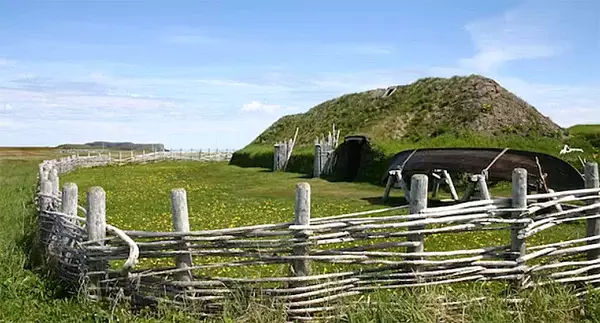
Information